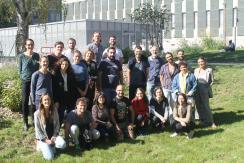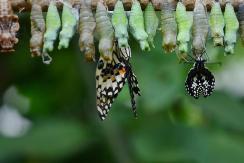COEVOL Multi-Scale Coevolution
Living systems are highly integrated, with a multitude of levels of organization, from molecular and intra-cellular scales to ecosystems. Complex organisms are themselves consortia of macro- and micro-organisms, which work together with their host to build the individual. Yet, each of these organisms can function and evolve in the short term according to its own logic, possibly in conflict with other higher or lower levels, or with other time scales. The once common idea among evolutionists that natural selection results in organisms perfectly adapted to their environment is now severely undermined. Not only because, as the Red Queen explains to Alice, one has to run relentlessly to keep its place in a changing environment, or because past evolutionary history and chance constrain the possibilities of present adaptation, but also because different levels of selection have interests that are generally difficult to reconcile.
Multi-scale coevolution resets classical questions in evolutionary biology
One example, of particular interest is the question of the source of heritable variations. The phenotype of organisms in a population is influenced not only by variations in their nuclear and mitochondrial genomes, the dynamics of which is the object of population genetics, but also more and more patently by the consortium of microbes and genetic elements that constitute its microbiome and virome. The hologenome designates this complex assembly of genetic materials, which obey different rules of transmission and different evolutionary strategies. The ability of symbionts to manipulate host phenotypes or to interfere with each other influences the evolutionary dynamics of all players in ways that are yet poorly understood. In addition, new questions arise, such as the importance of co-adaptation in these systems and their consequences in maintaining cohesive biological systems.
- Symbiosis: a response to and a source of divergent selection
Using a variety of approaches combining experimental evolution, genomic, functional, phenotypic and behavioral data, we aim to test whether symbiosis facilitates diversification and to characterize the underlying microevolutionary processes.
- Ecological networks of horizontal gene transfer
We develop original methods to detect gene transfer and we investigate the factors that influence the routes of gene transfers among microbes but also among insects.
- The interplay between symbiosis, infection and immunity and its evolutionary consequences
We try to understand the intimate interaction of hosts with pathogens, symbionts and transposable elements and how it affects the extended phenotype of the host.
- Transgenerational inheritance and environment changes
We try to decipher the molecular mechanisms that underlie rapid adaptation to environment and to test for transgenerational inheritance of fitness traits.
- Intragenomic conflicts and demography
We are developing models to test whether changes in the demography of the host affect the dynamics of transposable elements.
- The determinism of phenotypic convergence
We study the genomic basis of convergent phenotypic evolution in particular in the case of animals and plants adaptation to increasing temperature and decreasing water.
- Reconciling the tree of life
We develop phylogenetic methods for “reconciling” gene/species or host/symbiont histories and use these methods to explore the bulk of extinct or undescribed species and the history of association of symbiotic microbes with their hosts.
Integrating methods
The methods we use to tackle the questions raised by multi-scale co-evolution extend from theory, modelling and simulation to big data analysis, lab (notably on insects), and to a lesser extent, field activities.
Implication of research, responsibility of researchers and citizen sciences
From our research (some of which have immediate consequences in health, agriculture and ecology) and our concerns about the responsibility of scientists in society, we are committed to promote an “implicative” research. The implicative position means that we try to work on the link between science and society, not only through a one-way communication, applying or explaining our science, but also favoring early discussions on research projects, that may influence our research directions.
Publications
Display of 571 to 600 publications on 709 in total
Parallel Adaptations to High Temperatures in the Archean Eon
Nature . 456 ( 7224 ) : 942-945
DOI: 10.1038/nature07393
Journal article
see the publicationThe evolution of retrotransposon regulatory regions and its consequences on the Drosophila melanogaster and Homo sapiens host genomes
Gene . 390 ( 1-2 ) : 84-91
Journal article
see the publicationBehavioural manipulation of insect parasitoids by a maternally inherited virus: ecological consequences and potential applications for biological control
Entomological Research . 37 : A11-A73
Journal article
see the publicationEvolution and invasion dynamics of multiple infections with Wolbachia investigated using matrix based models.
Journal of Theoretical Biology . 245 : 197-209
Journal article
see the publicationParasitic inhibition of cell death facilitates symbiosis.
Proceedings of the National Academy of Sciences of the United States of America . 104 ( 1 ) : 213-5
Journal article
see the publicationTomato yellow leaf curl virus transmission efficacy is determined by symbiotic bacteria in the vector the sweet potato whitefly Bemisia tabaci
Entomological Research . 37(1) : A42-A43
Journal article
see the publicationA Survey of the Bacteriophage WO in the Endosymbiotic Bacteria Wolbachia
Molecular Biology and Evolution . 24 : 427-435
Journal article
see the publicationVariable-Number Tandem Repeats as Molecular Markers for Biotypes of Pasteuria ramosa in Daphnia spp
Applied and Environmental Microbiology . 73 : 3715-3718
Journal article
see the publicationEvolutionary Pathways of the tirant LTR Retrotransposon in the Drosophila melanogaster Subgroup of Species
Journal of Molecular Evolution . 64 : 438-447
Journal article
see the publicationThe solution space of sorting by reversals
3rd International Symposium on Bioinformatics Research and Applications (ISBRA 2007) . 4463 : 293-304
Conference paper
see the publicationEvolution under Reversals: Parsimony and Conservation of Common Intervals
IEEE/ACM Transactions on Computational Biology and Bioinformatics . 4 : 301-309
Journal article
see the publicationAdvances on sorting by reversals
Discrete Applied Mathematics . 155 : 881-888
Journal article
see the publicationThe effects of age at mating on female life-history traits in a seed beetle
Behavioral Ecology . 18 : 551-555
Journal article
see the publicationA New Method for Assessing the Effect of Replication on DNA Base Composition Asymmetry
Molecular Biology and Evolution . 24 : 2169-2179
Journal article
see the publicationHorizontal Gene Transfer Regulation in Bacteria as a ‘‘Spandrel'' of DNA Repair Mechanisms
PLoS ONE . 2 ( 10 ) : e1055-e1066
Journal article
see the publicationA congruence index for testing topological similarity between trees
Bioinformatics . 23 ( 23 ) : 3119--3124
Journal article
see the publicationMareyMap: an R-based tool with graphical interface for estimating recombination rates
Bioinformatics . 23 : 2188-2189
Journal article
see the publicationThe Sublethal Effects of Pesticides on Beneficial Arthropods
Annual Review of Entomology . 52 : 81-106
Journal article
see the publicationInteraction between host genotype and environmental conditions affects bacterial density in Wolbachia symbiosis
Biology Letters . 3 : 210-213
Journal article
see the publicationReverse Arrangement of rRNA Subunits in the Microsporidium Glugoides intestinalis
Journal of Eukaryotic Microbiology . 54 : 83-85
Journal article
see the publicationInsertion polymorphism of transposable elements and population structure of Anopheles gambiae M and S molecular forms in Cameroon
Molecular Ecology . 16 : 441-452
Journal article
see the publicationWhen can host shifts produce congruent host and parasite phylogenies? A simulation approach
Journal of Evolutionary Biology . 20 ( 4 ) : 1428--1438
Journal article
see the publicationComparative genomics and the evolution of prokaryotes
Trends in Microbiology . 15 : 135-141
Journal article
see the publicationGenome characteristics of facultatively symbiotic Frankia sp. strains reflect host range and host plant biogeography
Genome Research . 17 : 7-15
DOI: 10.1101/gr.5798407
Journal article
see the publicationMitspieler der Evolution
Spektrum der Wissenschaft . S44 : 44-49
Journal article
see the publicationA New Method for Assessing the Effect of Replication on DNA Base Composition Asymmetry
incollection . 7 : 379-381
Journal article
see the publicationEffective Stochastic Local Search Algorithms for the Genomic Median Problem
Doctoral Symposium on Engineering Stochastic Local Search Algorithms (SLS-DS) . : 1-5
Conference paper
see the publicationA Markovian Approach for the Analysis of the Gene Structure
Prague stringology conference . 19 ( 1 ) : 19-35
Conference paper
see the publication

